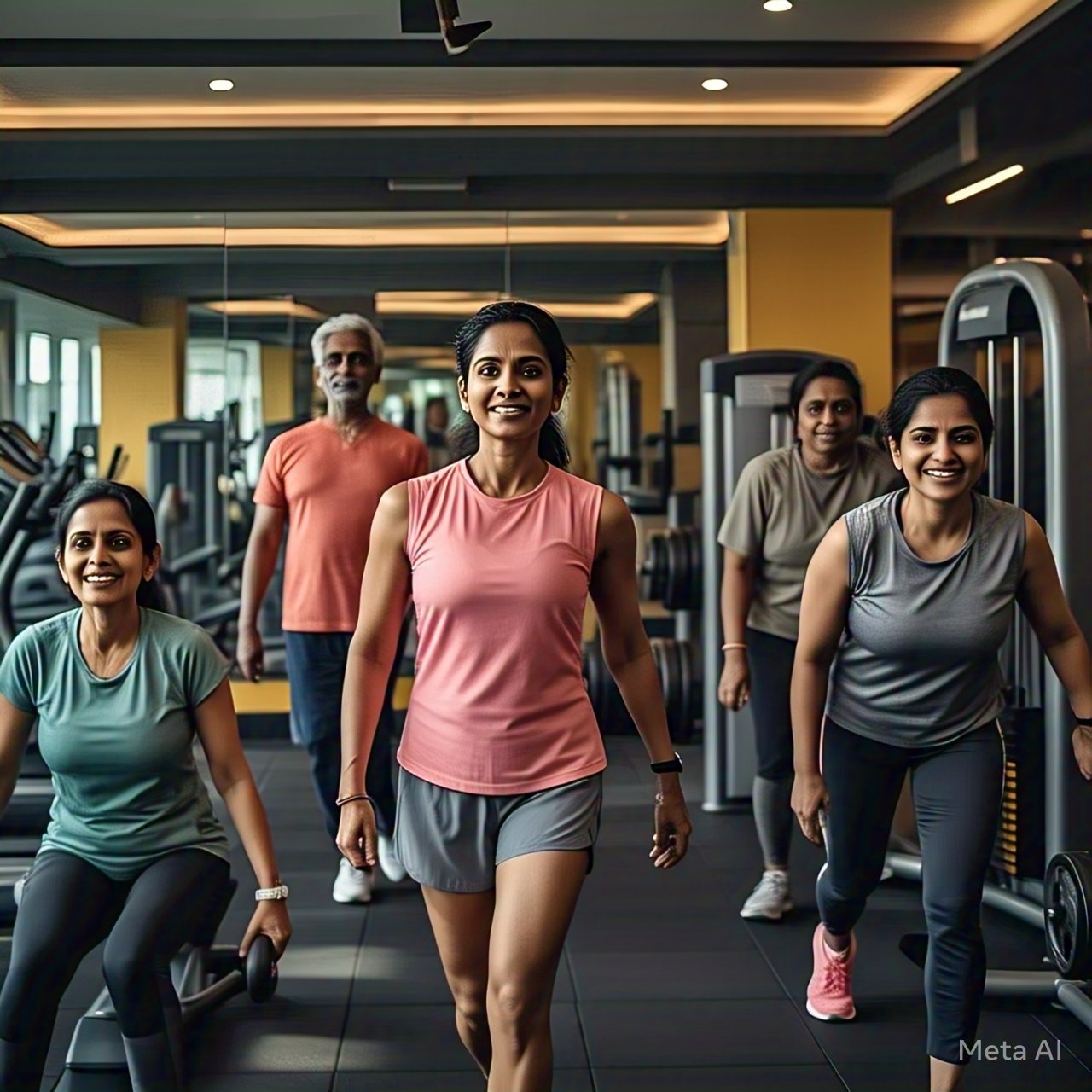Role of Fitness in India Society

Fitness in India is not a recognized “industry”, as yet. We do not even have a pan-India association to lobby the government for industry recognition. To be fair, some efforts are underway in the right direction and let us see how the situation pans out over the next few years.
Given India’s population and the demographics underlying it, it is a matter of time before Fitness explodes as a humungous industry!
According to a report in Tata Fintech’s Market Brew (October 2023) there were about 64,148 gyms in India. An abysmally low percentage of Indians exercise in the gym – 0.2% as compared to Norway’s gym membership adoption rate of 22% and the 21.2% in the UAS and 15.6% in the UK!
[SOURCE: https://www.marketbrew.in/weekly-insights/fitness-ecosystem]
To be fair though, I am not sure if the survey included akahdas for wrestling, kalaris for kalaripaittu or for that matter the dojos for Far Eastern martial arts, all of which are also centers for Fitness.
Whatever the definitions used in the survey, give or take a few thousands, India’s burgeoning population was 143.81 billion in 2023. According to Worldometer’s “live” counting, India’s population at 3.30 am, March 23, 2025 was 1,460,302,500 (based on Worldometer’s elaboration of the latest United Nations data).
Let’s consider these figures too:
- The median age in India is 28.8 years.
- 08% of the population is urban (542,742,539 people in 2025)
- India’s Total Fertility Rate (TFR) – the average number of children a group of women would have by the end of their reproductive years (ages 15 to 49) if they followed the current fertility rates throughout their lives, assuming no mortality. It is expressed as children per woman. As per the National Family Health Survey (NFHS-5) (2019-21), the TFR has declined to 2.0 children per woman from 2.2 children per woman (NFHS- 4 (2015-16). A TFR lower than 2.1, however, can lead to negative population growth, potentially causing long-term demographic challenges, including an ageing population.
- Life Expectancy: 72.5 at birth for both sexes
It is precisely because of our demographics that I believe that Fitness is a Career of the Future that is –
- Emotionally satisfying
- Financially lucrative
- Socially acceptedSomeone asked me why Fitness as a career when Indian youngsters now aspire to be astronauts! On the other hand, a lot many of us feel rozi – roti – survival – is the main preoccupation across India. Fitness can come later.
I see the rationale: on the one hand, high tech aerospace and AI, etc., while on the other, the physical work for survival, whether in the fields, farms, factories or offices is inevitably essential.
Fitness on the other hand is a voluntary – optional – leisure activity. Sure, Fitness is no rocket science any way but here’s what I believe:
- Each one of us requires to be fit. Fitness is not oversized muscles or extreme aerobic endurance.
- It is a permutation combination of 16 Fitness goals that lead us to better health.
- So, now, what’s better health? In simple terms:
- ability to perform routine physical tasks with comparative ease
- ability to cope with stress – physical, mental and emotional. In fact, Fitness is the best medium of trauma management!
- ability to prevent or swiftly recover from illnesses – especially the NCDs
- ability to enhance self-image, self-confidence, self-esteem
- helps develop the beautiful quality to endure pain and crises, and marshal one’s cognitive powers.
- Voluntary, yes. Leisure, yes. But to be able to utilize “spare time” for Exercise and / or Sport requires DISCIPLINE! And, surely, you will agree with me if I say discipline is the need of the hour? No family, community, organization or Nation can progress unless the socio-economic fabric is founded on discipline.
The fact is, Fitness has the powerful potential to help India across several problematic areas. Let’s take a general look at some of them!
PRODUCTIVITY
Suffice to say that, low labour productivity has been a traditional concern for India. I fear to tread on the space of statistics which economists, statisticians and business managers are comfortable with. Nevertheless!
A study by the Indian Council for Research on International Economic Relations (ICRIER) suggested that Indian companies were suffering absenteeism as long as 51 days in a year due to sickness among workers. The value of the loss of productivity and profits, if calculated, would be sizeable. Significantly, lifestyle diseases or NCDs cardiovascular diseases, diabetes, stroke and mental disorders are found to be at the root of absenteeism.
Interestingly, the loss of productivity is not restricted to urban areas. Rural India – that is, agriculture and related sectors – is also suffering.

The NCDs burden can be seen in terms of Disability-Adjusted Life Years or DALYs that quantify the years of productive life lost due to premature mortality and years with disability. According to a study by the Indian Council of Medical Research, in India, from 1990 to 2016, the proportion of total DALY attributable to NCDs increased from 30.5% to 55.4%. In 2017, India had about 9·7 million deaths and 486 million DALYs. More than 75% of deaths and DALYs occurred in rural areas. Men accounted for 54·3% of all DALYs. At all ages, the DALY rate per 1,00,000 population was 36,300, but rates were higher among rural residents and among males. NCDs comprised 46·6% of DALYs overall, which increased to 55·0% in urban areas. Injuries comprised 11·4% of DALYs. NCD and injury DALY rates were higher in males than females.
SOURCE: The Lancet Health December 2019
https://www.thelancet.com/journals/langlo/article/PIIS2214-109X(19)30451-6/fulltext

Fitness can stimulate productivity
Any number of studies have shown that exercise, good health and productivity are directly interrelated. Exercise –
- helps prevent and manage NCDs and other illnesses,
- improves cardiovascular health
- helps in quicker and longer lasting rehab and prehab of injuries.
- increases strength and local muscular endurance – minimises tiredness and fatigue,
- improves self -esteem and self-image.
Exercise leads to Fitness and better health and, therefore, higher productivity – given the external factors are equal – in people irrespective of whether or not they suffer medically.
NCDs
India is experiencing the rising burden of NCDs, with limited access to health care and social security. The WHO estimates that NCDs account for 63% of all deaths, out of which 27% of the deaths are from cardiovascular disease, 9% from cancer, 3% from diabetes, and 11% from chronic respiratory disease in India.
There are numerous NCDs but we look at a few common in India.
Cancer
The estimated number of incident cases of cancer in India for the year 2022 was found to be 14,61,427 (crude rate:100.4 per 100,000). In India, one in nine people are likely to develop cancer in his/her lifetime. Lung and breast cancers were the leading sites of cancer in males and females, respectively. Among the childhood (0-14 yr) cancers, lymphoid leukaemia (boys: 29.2% and girls: 24.2%) was the leading site. The incidence of cancer cases is estimated to increase by 12.8 per cent in 2025 as compared to 2020.
SOURCE: Indian J Med Res. 2023 Mar 11;156(4-5):598–607. doi: 10.4103/ijmr.ijmr_1821_22
Diabetes
An Indian Council of Medical Research (ICMR) study estimates that India – the world’s most populous country – has 101 million people with diabetes. A study of more than 113,000 people also found that around 15% of Indians were pre-diabetic and around 35% have hypertension. It was conducted between October 2008 and December 2020 across 31 Indian states and territories.
Coronary Heart Disease – CHD
There has been a 4-fold rise of CHD prevalence in India during the past 40 years. Current estimates from epidemiologic studies from various parts of the country indicate a prevalence of CHD to be between 7% and 13% in urban and 2% and 7% in rural populations. Incidentally, The Global Burden of Diseases Study reported that the disability-adjusted life years lost by CHD in India during 1990 was 5.6 million in men and 4.5 million in women; the projected figures for 2020 were 14.4 million and 7.7 million in men and women respectively.
Obesity
Over half of India is obese. Of the nearly 7 lakh respondents, 13.85% and 57.71% were with obesity and abdominal obesity, respectively. Although approximately 12% of the population is suffering from obesity, the prevalence of abdominal obesity was high in every BMI subcategory
SOURCE: Obesity and Abdominal Obesity in Indian Population: Findings from a Nationally Representative Study of 698,286 Participants: https://pmc.ncbi.nlm.nih.gov/articles/PMC10204471/
Exercise and NCDs
Here’s a brief summary of how exercise can help prevent the onset of and / or facilitate swifter rehab from NCDS.
- Reducing the Risk of Developing NCDs:
- Cardiovascular Diseases: Exercise strengthens the heart and improves blood vessel function, reducing the risk of heart disease, stroke, and other cardiovascular problems.
- Type 2 Diabetes: Regular physical activity helps improve insulin sensitivity, which is crucial for regulating blood sugar levels and preventing or managing type 2 diabetes.
- Certain Cancers: Studies suggest that regular exercise can lower the risk of developing certain cancers, including breast, colon, and endometrial cancer.

- Obesity: Exercise helps burn calories and maintain a healthy weight, which is a major factor in preventing and managing obesity, a significant risk factor for many NCDs.
- Osteoporosis: Weight-bearing exercises, like walking and running, can help strengthen bones and reduce the risk of osteoporosis.
- Improving Cardiovascular Health:
- Lowering Blood Pressure: Regular exercise helps lower blood pressure, a major risk factor for cardiovascular diseases.
- Improving Cholesterol Levels: Exercise can help lower LDL (bad) cholesterol and raise HDL (good) cholesterol, further reducing the risk of heart disease.
- Improving Lung Function: Exercise strengthens the lungs and improves their capacity, which is important for overall cardiovascular health.
- Enhancing Overall Well-being:
- Reducing Stress and Anxiety: Exercise releases endorphins, which have mood-boosting effects and can help reduce stress and anxiety, which can contribute to the development of NCDs.
- Improving Sleep Quality: Regular physical activity can improve sleep quality, which is important for overall health and well-being.
- Boosting Energy Levels: Exercise can help increase energy levels and reduce fatigue, which can improve quality of life.
- Improving Mental Health: Exercise can improve cognitive function, reduce the risk of cognitive decline, and enhance overall mental health.
It is now a known fact that Exercise can be used as a Medication. Its efficacy is based on the consistent application of what I call the Exercise Medicine Triad (EM3) –
- Accurate fitness assessment and analysis of the patient’s medical condition and reports
- Accurate exercise prescription in the right dosage
- Safe and diligent administration of the dosage through appropriate training.
TRAUMA
India is a multicultural, multireligious society. Trauma, in all its forms – transgenerational or intergenerational, acute, chronic or complex with or without post-traumatic syndrome disorder (PTSD). In fact, the National Mental Health Survey (NMHS) 2015-2016 reported a low prevalence of PTSD at 0.2% in the general population.
An Ipsos global survey on World Mental Health Day 2024, 1 in 2 urban Indians (53%) admitted to experiencing stress to the extent that it impacted their daily life in the last one year; 1 in 4 (22%) have been in such a stressful scenario several times while 31% have experienced stress at least once. Indeed, mental health has emerged as a growing concern around the world as per this Ipsos survey conducted in 31 countries.
The report also looked at the incidence of stated depression – a common but serious mood disorder: 1 in 4 urban Indians (25%) have felt depressed to the point that they felt sad or hopeless almost every day for a couple of weeks or more in the last one year.
Globally, 76% people feel that mental health is as important as physical health while only 13% believe that mental health is more important. Interestingly, in India, 21% felt that mental health is more important than physical health. Interestingly, Malaysia had at least 63% emphasizing on the importance of both physical and mental health equally.
And, how often do Indians think about their physical wellbeing? Well, India had only 48%! While this placed us lowest across all markets polled, some markets showed alarming degree of preoccupation with physical health, especially in South Africa (86%), Indonesia (85%), Peru (85%) and Colombia (84%)! However, in case of their own physical and mental wellbeing, half (50%) of the urban Indian citizens polled, both their physical and mental health emerged important.

I will write in detail, separately, about the role of exercise in trauma management but at this point in time, I can state with conviction that a qualified Fitness professional will be able to prescribe and implement a body of exercises that –
- helps relieve stress – happy hormones, remember!
- improves cognitive function – better focus and attention, enhanced creativity, etc
- improves cardiovascular health
- helps in quicker and longer lasting rehab and prehab of injuries.
- improves self -esteem and self-image.
Exercise is a valuable tool for managing trauma and its symptoms including PTSD, by promoting physical and mental well-being, helping to regulate emotions, and potentially reducing stress and anxiety. Here’s how:
- Physical and Mental Benefits: Exercise has been proven to improve mood, reduce anxiety and depression and enhance sleep quality – all of which benefit individuals struggling with trauma.
- Regulation of the Nervous System: Engaging in physical activity and exercise can help detach the nervous system from the immobilization stress response often associated with trauma, promoting a sense of grounding and control. When a person experiences trauma, his nervous system can become “stuck” in a state of immobilization, in suspended animation as it were, numb or disconnected from his body. Exercise, when focused on the physical sensations of movement, can help the nervous system move out of this state.
- Focus: By focusing on the physical sensations of exercise, trauma patients can shift their attention away from negative thoughts and feelings, thereby promoting a sense of embodiment and internal awareness.
- Social Support: Participating in group exercise or outdoor activities can foster social connections and a sense of belonging, which can be crucial for trauma recovery.
Of course, the knowledgeable fitness professional will be sensitive enough to guide the client, keeping in mind that he or she is a cog in the wheel that will roll the client to normalcy and safety. The other cogs, of course, will generally be the psychiatrist, the medical doctor, physiotherapist and the nutritionist.
IN SUM
Like the rest of the world, India too is afflicted by the loss of human productivity, non-communicable diseases and trauma. Given our humongous, heterogenous population, these problems are inevitable.
The infrastructure and manpower required to cater to the Indian population is nowhere near what we require despite government and private sector initiatives.
In a statement to the Lok Sabha in November 2024, the Union Health Minister, J. P. Nadda, stated that the doctor-population ratio is 1:811 in the country – better than the WHO standard of 1:1000 – assuming 80% availability of the 13.9 lakh allopathic doctors registered with the State Medical Councils and the National Medical Commission (NMC) and around 6.14 lakh AYUSH doctors.
The number of psychiatrists in India currently is about 9,000. Added to this, about 700 psychiatrists graduate every year. Going by this figure, India has 0.75 psychiatrists per 100,000 citizens, while the desirable number is anything above 3 psychiatrists per 100,000.
Building the health infrastructure and training the personnel – an on-going process – does and will consume large volumes of time, effort and funds.
Let us not forget, mercifully, a vast majority of Indians are not (yet, at least) in the Special Populations discussed above! They continue to have the typical Fitrness goals like fal loss, muscle gain, increased endurance, better flexibility, etc. They too have been traumatized by the COVID-19 experience.
Fitness is for all above 6 years in age, with or without medical conditions. Then you also have kids and adults wanting to get into sports for leisure pastime or competing. Oh, I have not even touched the issue of the elderly in India! I will discuss this topic separately, at a later date.
All of them will have a permutations and combinations of 16 Fitness goals or types, which a qualified Fitness professional ought to be able to address. There are eight general training technologies that will help deliver the Fitness goals. So, in effect, the 16 X 8 matrix will help 128 types of clients across the population!
Given the circumstances, Fitness can provide swift, economical solutions for bettering the health of Indian society. Health is the bedrock of any Nation. To train a fitness professional is not time-consuming. To install a fitness facility does not really cost much money and space. The regulatory body will arise in the natural process in tandem with the realization of the role of Fitness in society and Nation Building.

As I end this article, about 5 hours since I started, the population, according to Worldometer, has increased by 5,207 to 1,460,307,707!
Yes! Fitness offers great career opportunities!

